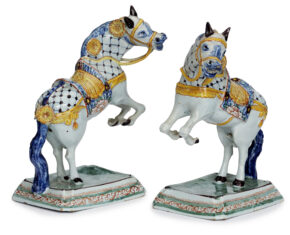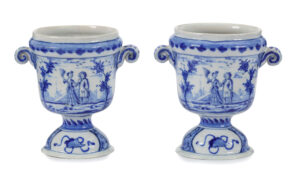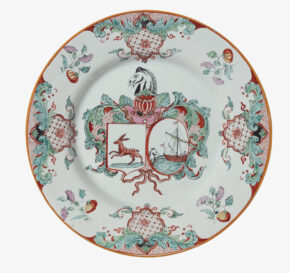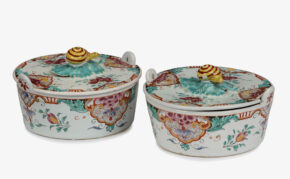![]()
Images on this website are licensed under a
Creative Commons Attribution-NoDerivs 3.0 Unported License.
OBJECT
D2403. Large Blue and White Charger
Delft, circa 1670
Marked IW 7 in blue for Jacob Wemmersz. Hoppesteyn, the full owner of Het Moriaanshooft (The Moor’s Head) factory from 1664 until 1671, and succeeded by his widow Jannetge Claesdr. van Straten through 1686
Painted in blue, the center with a duck positioned on a rock in front of lavish floral branches, on the left a bird in flight within two concentric lines encircled with four prunus branches with a chrysanthemum, the cavetto rim in ‘kraak’-style with four fan-shaped panels depicting floral motifs, alternating with four fan-shaped panels decorated with a bird on rock work surrounded by branches and a floral branch, all separated by narrow panels with stylized flowers.
DIMENSIONS
Diameter: 34.2 cm. (13.5 in.)
NOTE
Het Moriaanshooft (The Moor’s Head) factory was located in the Gasthuislaan in Zuidkant, an area in Delft with a large concentration of potteries. There are three main phases that mark the factory’s history: the beginning of the factory and its development under the Hoppesteyn family (1658-1690), the division of the factory into two independent companies (1690-1772), and the reunion of the factory into one functioning pottery (1772-1792).
Het Moriaanshooft factory was one of the early potteries in Delft, though the date of its founding and the history of ownership is uncertain until 1658/59 when Jacob Wemmersz. Hoppesteyn became part owner. A few years later, Hoppesteyn purchased the remaining company shares as well as the tools and two pottery washing plants, becoming the primary owner of Het Moriaanshooft factory. According to Van Dam, Wemmersz. Hoppesteyn was originally a cooper. It is likely that he never left his occupation and that he entrusted his mother-in-law, Adriaantje Jandr. van der Sande with the management of the company, as well as the day-to-day operations. In fact, when Jacob Hoppesteyn became the sole owner of the factory, the lease stipulated that the company was leased for at least another three years to Adriaantje. Adriaantje was the wife of Claes Jansz. van Straten, the owner of De Lampetkan (The Ewer) factory. When he died in 1653, she claimed leadership of the factory.
Over the next thirty years, the company progressively grew to become a major figure in the history of Delftware. The objects made by Het Moriaanshooft in this period are in fact amongst the most rare and remarkable of all Delftware production. A document from 1669 states the names of at least nineteen ‘plateelbakkersknechten’ (potters’ assistants) aged between 17 and 55 years old who were employed by Hoppesteyn.
After Hoppesteyn’s death in 1671, his wife, Jannetge Claesdr. van Straten, assumed the management of the business. Jannetge’s prompt remarriage later that year to Willem van Teylingen, the prosperous and entrepreneurial owner of the house next door to Het Moriaanshooft, enhanced the business through his acquisition of real estate. The union also enabled the son, Rochus Hoppesteyn to continue his father’s technical experimentation, which resulted in the production of high quality objects and a new type of polychrome decoration produced through the mixed-fire technique. In this process, the decoration was first applied on the object and then fired at a high temperature. Next, gold was applied during a third fire at a low temperature, resulting in an exceptionally refined object that was undoubtedly intended for the highest class.
In 1679 Willem van Teylingen died and Jannetge became a widow again, at which time, her son Rochus joined her as co-owner of the factory. Although by a law of 1652 a widow inheriting the ownership of a factory was not required to take the usual rigorous examinations for admittance to the Guild of Saint Luke, her son and co-owner Rochus was not exempt. In 1680, he was admitted to the Guild as a master painter, and was then allowed to become the factory manager. With his managerial responsibilities, his role in the factory’s products is not known. It is recorded that he employed other painters, including Jeremias Godtling and his successor as master painter, Gijsbrecht Verhaast, a somewhat independent artist in Delft (and the grandfather of the better-known Gijsbrecht Verhaast), but it is also recorded that Rochus was far more skilled as a painter than as a manager.
Upon the death of his mother in 1686, Het Moriaanshooft factory became the property of Rochus Hoppesteyn and his wife Alida Lansvelt. Rochus’s dearth of business acumen, his reluctance to pursue creditors and his tendency toward dissolute behavior, however, caused both financial and marital difficulties. Rochus was forced to sell a significant part of the factory in 1690, including its outbuildings and four houses. The remaining portion of the business was re-named Het Oude Moriaanshooft (The Old Moor’s Head), and the smaller portion belonging to Rochus was called Het Jonge Moriaanshooft (The Young Moor’s Head). He continued to mismanage this business for the final two years of his short life, leaving his widow to inherit a factory in financial ruin.
By May 2, 1692, the factory’s assets, liabilities and even its stock of unfinished pieces had been inventoried (a copy of the document exists in the Delft Archives), and by July 1 of that year, Alida Lansvelt Hoppesteyn was forced to declare bankruptcy of Het Jonge Moriaanshooft (The Young Moor’s Head) factory. It was then sold to Lieve van Dalen, who, by the terms of the acquisition was required to assume the full burden of the business. Alida Hoppesteyn and her inherited predicament, however, must have received the full attention and sympathy of the Delft community; the final firings at her factory were accomplished with wood sold to her by Lambertus van Eenhoorn of De Metaale Pot (The Metal Pot) factory.
This charger was discovered at the shoot of Tussen Kunst & Kitsch, the Dutch version of the Antiques Roadshow, on May 9th, 2022.









